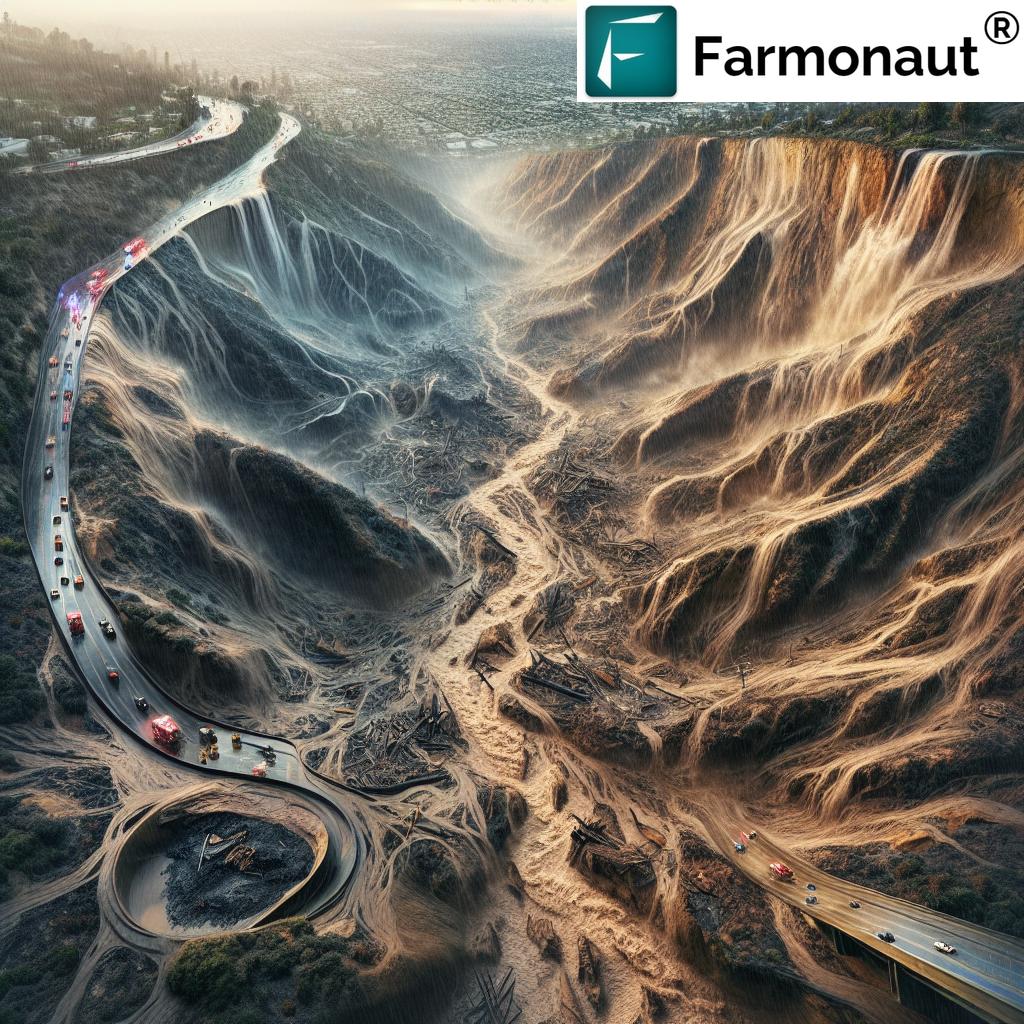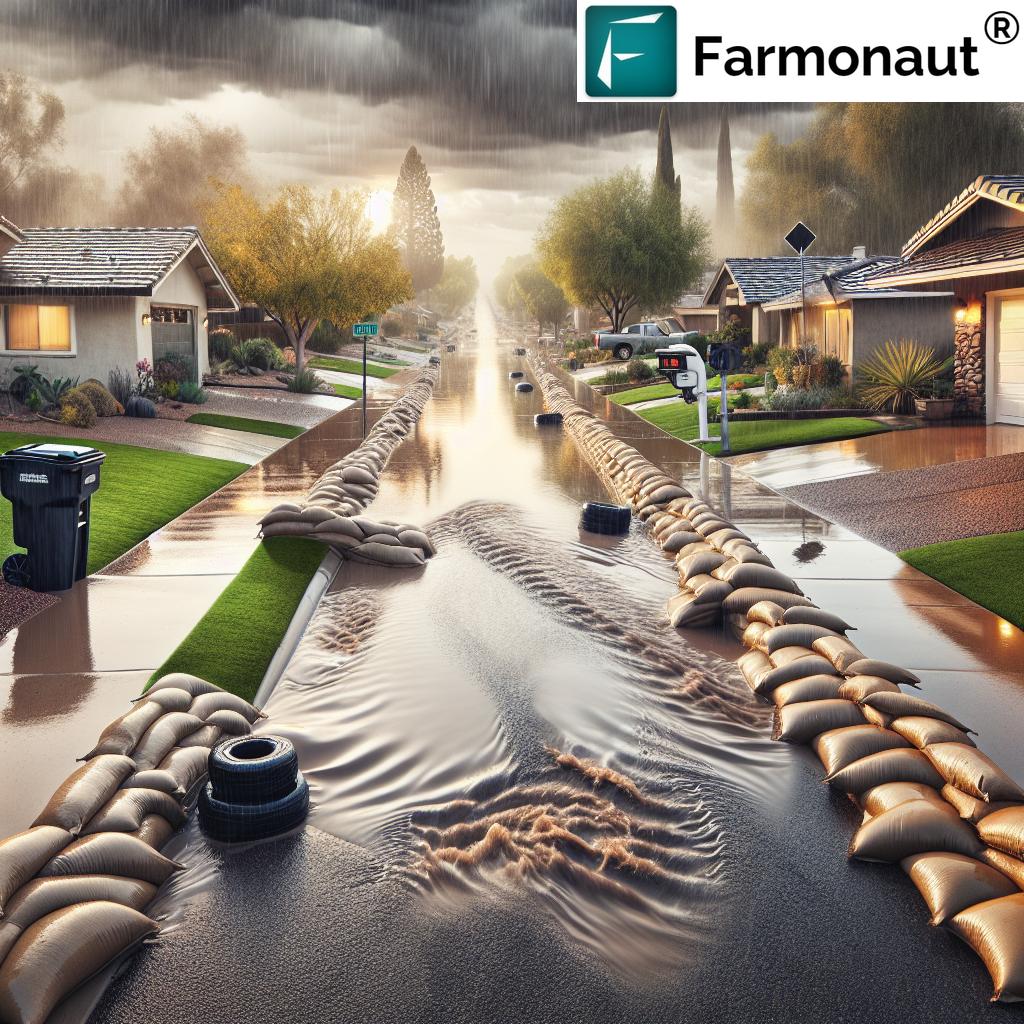Los Angeles Storm Warning: Preventing Disaster in Wildfire-Scarred Areas
“Los Angeles storm flooding threatens communities with rainfall rates up to 1 inch per hour in some areas.”
As we confront the latest climate-driven crisis in Southern California, our communities face a dual threat of recovering from devastating wildfires while bracing for potentially catastrophic flooding. The strongest winter storm of the season is upon us, bringing with it the risk of Los Angeles storm flooding and Southern California mudslides that could wreak havoc on our already vulnerable landscape.

In this comprehensive guide, we’ll explore the ongoing weather crisis, its environmental implications, and the crucial measures being taken to safeguard our communities. We’ll delve into expert insights on addressing these challenges and provide vital information on how residents can stay safe during this perilous time.
Understanding the Storm’s Impact on Wildfire-Scarred Areas
The convergence of recent wildfires and the incoming atmospheric river has created a perfect storm of potential disaster. Burn scar debris flows pose a significant threat to areas that have already suffered from the ravages of fire. Let’s break down the key factors contributing to this hazardous situation:
- Soil Instability: Wildfires leave behind charred hillsides with unstable soil that’s more susceptible to erosion.
- Reduced Absorption: The intense heat from fires can create a water-repellent layer on the soil, reducing its ability to absorb rainfall.
- Debris Accumulation: Burned vegetation and other debris can be easily swept up by heavy rains, contributing to dangerous mudflows.
- Rapid Runoff: With less vegetation to slow water flow, rainfall can quickly accumulate and rush downhill, potentially triggering flash floods and debris flows.
These factors combine to create a high-risk environment where even moderate rainfall can lead to severe consequences. The National Weather Service has warned of rain rates reaching up to an inch per hour in some locations, far exceeding the threshold for potential debris flows in recently burned areas.
High-Risk Areas and Evacuation Orders
As the storm intensifies, several areas across Los Angeles County have been identified as high-risk zones for flooding and mudslides. Mandatory evacuations have been ordered for residents in the following locations:
- 106 homes in Pacific Palisades
- 9 homes in the Sunset fire area
- 4 homes in the Hurst fire zone
- Various residences in Malibu, Altadena, San Dimas, and Palmdale
Additionally, evacuation warnings have been issued for burn-scarred regions including Brentwood, Sunset Mesa, Hollywood and Hollywood Hills West, Sylmar, Calabasas, Kinneloa Mesa, Arcadia, Sierra Madre, and parts of the San Gabriel Mountains.
It’s crucial for residents in these areas to heed evacuation orders and warnings. Your safety is paramount, and leaving quickly can make all the difference in an emergency situation.
Storm Preparedness and Safety Measures
For those not under immediate evacuation orders, taking proactive steps to prepare for the storm is essential. Here are some key measures to consider:
- Stay Informed: Keep abreast of the latest weather updates and emergency notifications from local authorities.
- Prepare an Emergency Kit: Include essentials like water, non-perishable food, flashlights, batteries, and first-aid supplies.
- Secure Your Property: Clear gutters and drains, and use sandbags to divert water flow away from your home if necessary.
- Have an Evacuation Plan: Know your evacuation route and have a designated meeting place for your family.
- Charge Electronics: Ensure your phones and other essential devices are fully charged in case of power outages.
- Avoid Flood-Prone Areas: Stay away from canyons, streams, and other areas known to flood during heavy rains.
“Recent wildfires have left burn scars across Southern California, increasing mudslide risks during the strongest winter storm.”
The Science Behind Burn Scar Debris Flows
Understanding the mechanics of burn scar debris flows is crucial for appreciating the gravity of the current situation. When heavy rain falls on fire-scarred hillsides, it can trigger a cascade of events leading to potentially devastating mudslides and debris flows.
Here’s a breakdown of the process:
- Soil Alteration: Intense wildfires change the physical properties of soil, often creating a water-repellent layer.
- Reduced Vegetation: The loss of plants and their root systems diminishes the soil’s ability to hold water and resist erosion.
- Rapid Runoff: When rain falls on these altered landscapes, it quickly accumulates on the surface instead of being absorbed.
- Debris Mobilization: As water flows downhill, it picks up ash, burned vegetation, and other debris, gaining mass and momentum.
- Flow Formation: The mixture of water, mud, and debris can form a fast-moving flow capable of traveling at speeds up to 35 mph.
These debris flows can be incredibly destructive, posing significant risks to life and property in their path. The U.S. Geological Survey (USGS) has conducted extensive research on this phenomenon, providing valuable data to help predict and mitigate these hazards.

Critical Infrastructure and Transportation Impacts
The storm’s effects extend beyond residential areas, posing significant challenges to our region’s infrastructure and transportation networks. Here are some key impacts to be aware of:
- Road Closures: Several major highways and local roads have been affected, including:
- Pacific Coast Highway in Malibu (closed between Chautauqua Boulevard and Carbon Beach Terrace)
- Various canyon roads in the Santa Monica Mountains
- Potential closures on portions of the 101, 5, and 210 freeways
- Public Transportation: Bus and rail services may experience delays or cancellations due to flooding or debris on tracks.
- Power Outages: Heavy winds and rainfall can lead to downed power lines and widespread outages.
- Airport Disruptions: Flights at LAX and other regional airports may face delays or cancellations due to the severe weather.
Residents are strongly advised to check road conditions and public transportation schedules before attempting any travel during this storm event. Stay informed about local conditions and follow guidance from transportation authorities.
Environmental and Long-Term Impacts
While our immediate focus is on safety and disaster prevention, it’s important to consider the broader environmental implications of this storm event, especially in the context of recent wildfires:
- Ecosystem Disruption: The combination of fire and flood can dramatically alter local ecosystems, potentially leading to long-term changes in flora and fauna.
- Water Quality Issues: Runoff from burn areas can contaminate water sources with ash, debris, and other pollutants.
- Soil Erosion: Significant loss of topsoil can impact agricultural productivity and natural habitats for years to come.
- Coastal Impacts: Debris flows reaching the ocean can affect marine ecosystems and coastal water quality.
These environmental challenges underscore the need for comprehensive, long-term strategies to address climate resilience and ecological restoration in our region.
Community Response and Support
In times of crisis, the strength of our community shines through. Here are some ways residents can support each other and contribute to recovery efforts:
- Check on Neighbors: Especially those who may be elderly, disabled, or living alone.
- Volunteer: Local organizations may need help with sandbagging, shelter operations, or other support activities.
- Donate: Consider contributing to reputable disaster relief organizations working in affected areas.
- Report Hazards: If you observe dangerous conditions, report them to the appropriate authorities immediately.
Remember, community resilience is built on the collective efforts of individuals working together to support and protect one another.
Los Angeles Storm Risk Assessment by Area
| Area | Wildfire Impact | Current Storm Risk | Recommended Actions |
|---|---|---|---|
| San Gabriel Valley | Severe (Eaton Fire) | High | Mandatory evacuation, prepare for debris flows |
| Westside (Pacific Palisades) | Moderate to Severe | High | Evacuation for high-risk zones, flood preparedness |
| Malibu | Moderate | Moderate to High | Be ready to evacuate, monitor PCH closures |
| Altadena | Moderate | Moderate | Prepare sandbags, clear drainage systems |
| Hollywood Hills | Light to Moderate | Moderate | Stay alert, prepare for potential mudslides |
Leveraging Technology for Disaster Preparedness
In today’s digital age, technology plays a crucial role in disaster preparedness and response. While our focus is on the immediate storm threat, it’s worth noting how advanced technologies are being employed to enhance our resilience to such events.
For instance, companies like Farmonaut are at the forefront of using satellite technology and artificial intelligence to monitor environmental conditions. While primarily focused on agricultural applications, such technologies demonstrate the potential for improved early warning systems and environmental monitoring that could be adapted for urban disaster preparedness.
Key technological advancements that are proving valuable in disaster management include:
- Satellite Imaging: For real-time monitoring of storm systems and flood-prone areas.
- AI-Powered Predictive Models: To forecast potential flood paths and high-risk zones.
- Mobile Apps: For disseminating real-time alerts and evacuation information to residents.
- Drone Technology: For rapid assessment of damage and identification of stranded individuals.
As we continue to face climate-related challenges, investing in and leveraging these technologies will be crucial for building more resilient communities.
FAQs About Los Angeles Storm Preparedness
- Q: How long is the current storm expected to last?
A: The strongest part of the storm is expected to pass by Friday, but residents should stay alert for potential aftereffects and additional rainfall. - Q: What should I do if I’m ordered to evacuate?
A: Follow evacuation orders immediately. Take only essential items, secure your home, and follow designated evacuation routes. - Q: How can I stay informed about the latest storm updates?
A: Monitor local news stations, follow official social media accounts of emergency services, and sign up for emergency alerts from your city or county. - Q: What items should be in my emergency kit?
A: Essential items include water, non-perishable food, flashlights, batteries, first-aid supplies, important documents, and any necessary medications. - Q: Is it safe to drive during the storm?
A: It’s best to avoid driving if possible. If you must drive, be aware of road closures, never drive through flooded areas, and be prepared for sudden changes in road conditions.
Conclusion: Building Long-Term Resilience
As we navigate through this immediate crisis, it’s crucial to reflect on the broader implications and the steps we need to take to build long-term resilience in our communities. The increasing frequency and intensity of extreme weather events, coupled with the ongoing threat of wildfires, underscore the need for comprehensive climate adaptation strategies.
Key areas for future focus include:
- Infrastructure Upgrades: Investing in flood-resistant infrastructure and improved drainage systems.
- Urban Planning: Implementing stricter building codes in high-risk areas and preserving natural flood buffers.
- Ecosystem Restoration: Accelerating efforts to restore fire-damaged areas to improve natural flood mitigation.
- Community Education: Enhancing public awareness and preparedness for various climate-related disasters.
- Technological Integration: Leveraging advanced technologies for better prediction, monitoring, and response to extreme weather events.
By taking a proactive, long-term approach to these challenges, we can work towards creating more resilient, sustainable communities that are better equipped to face the climate challenges of the future.
As we face this current storm, let’s remember that our strength lies in our unity and preparedness. Stay safe, stay informed, and look out for one another. Together, we can weather this storm and emerge stronger and more resilient.